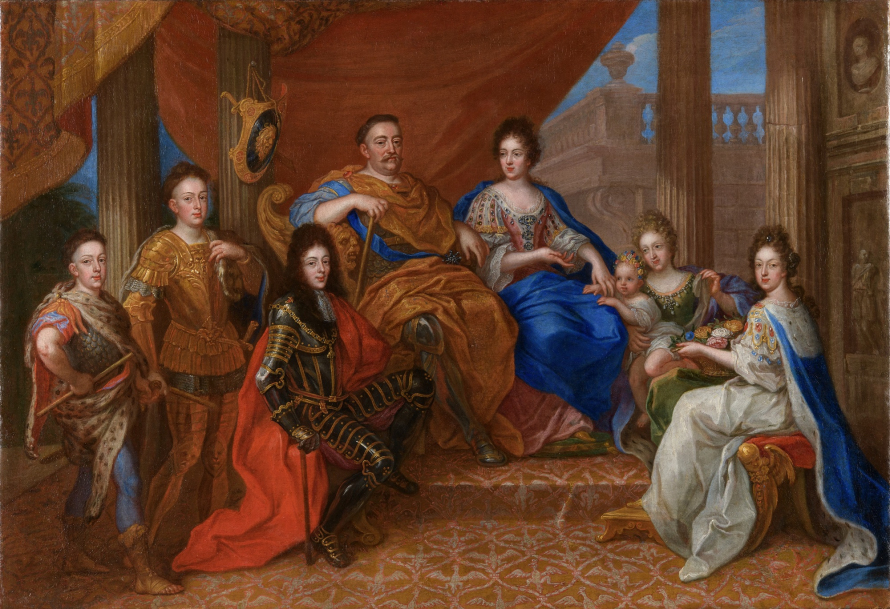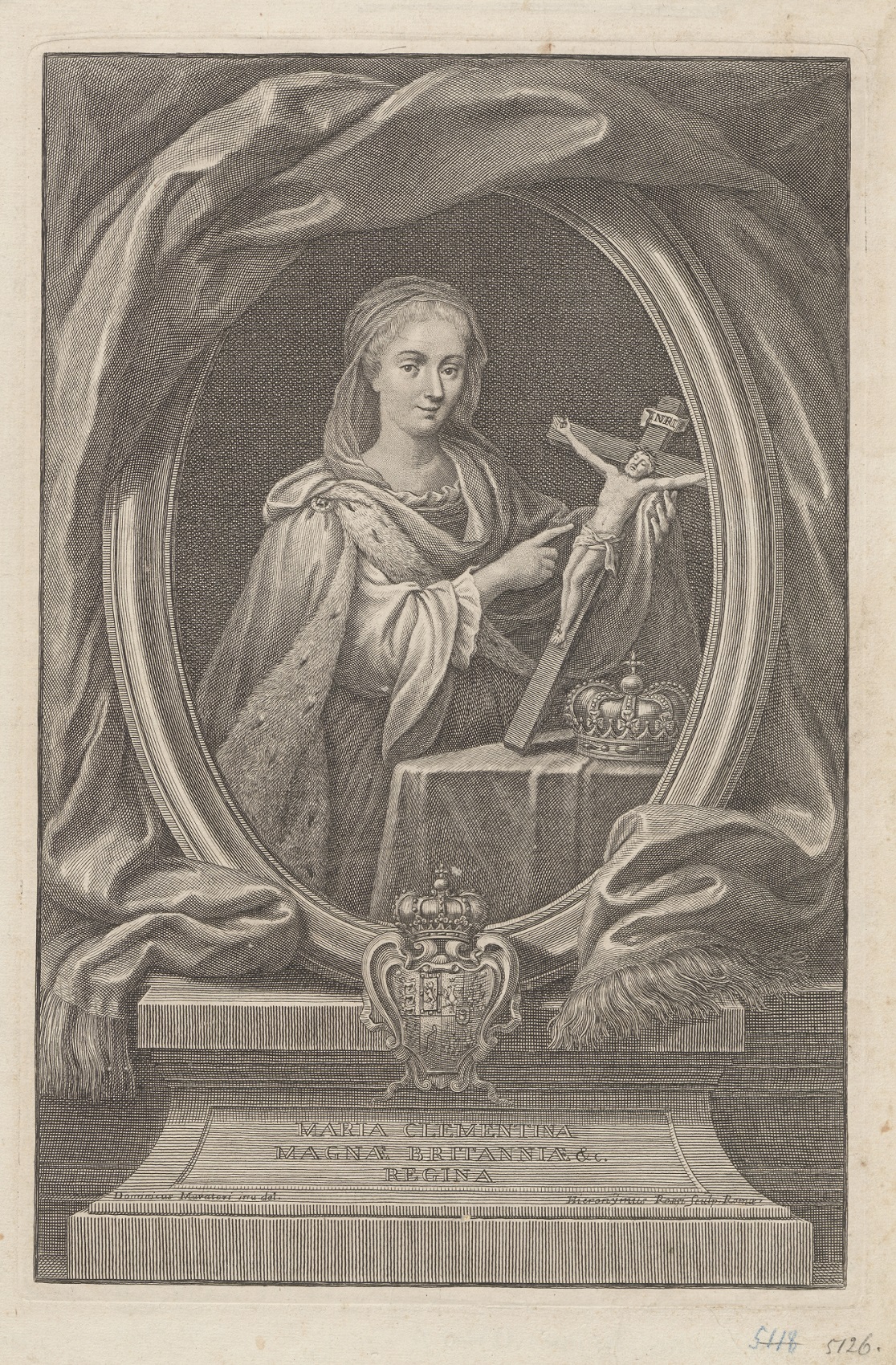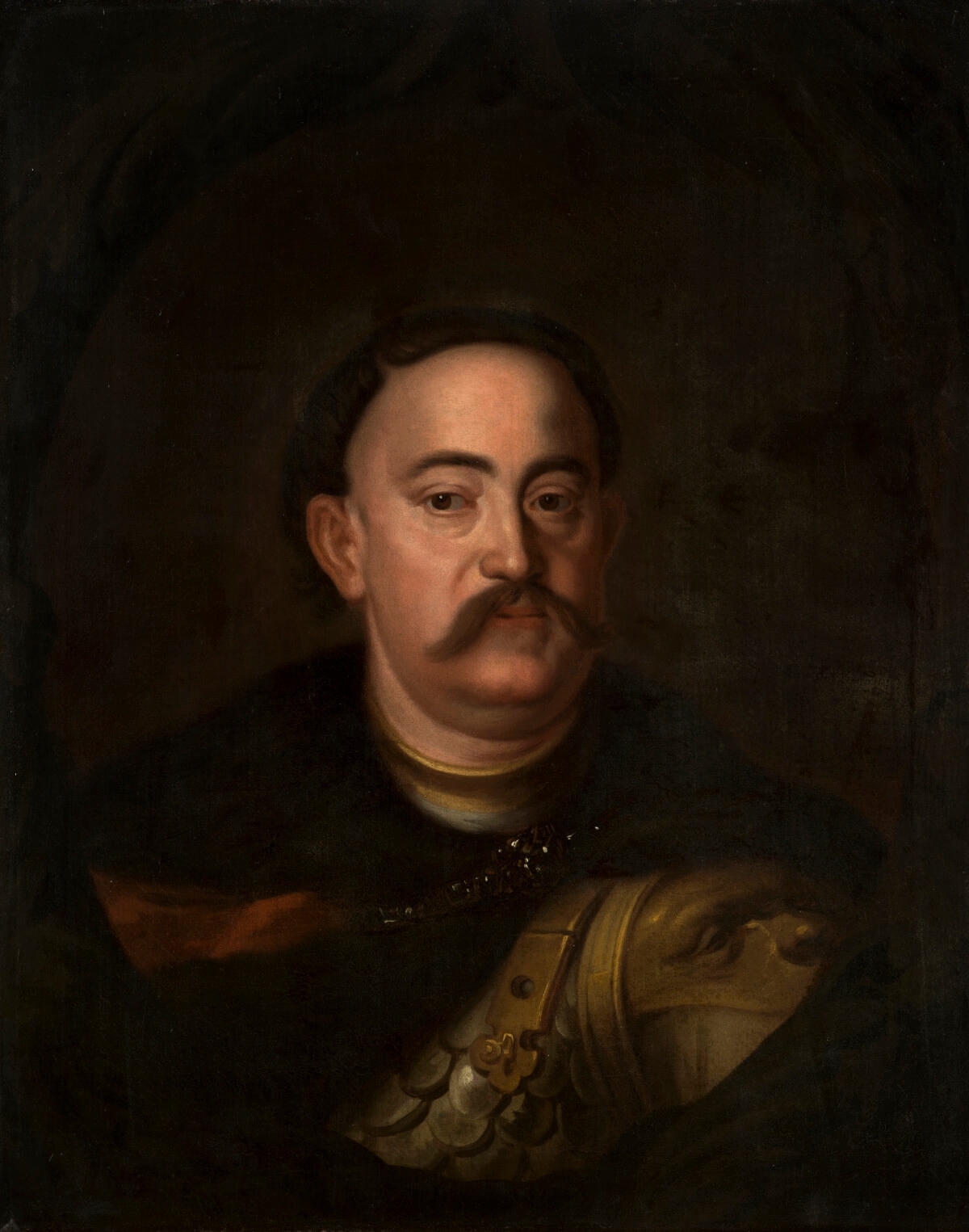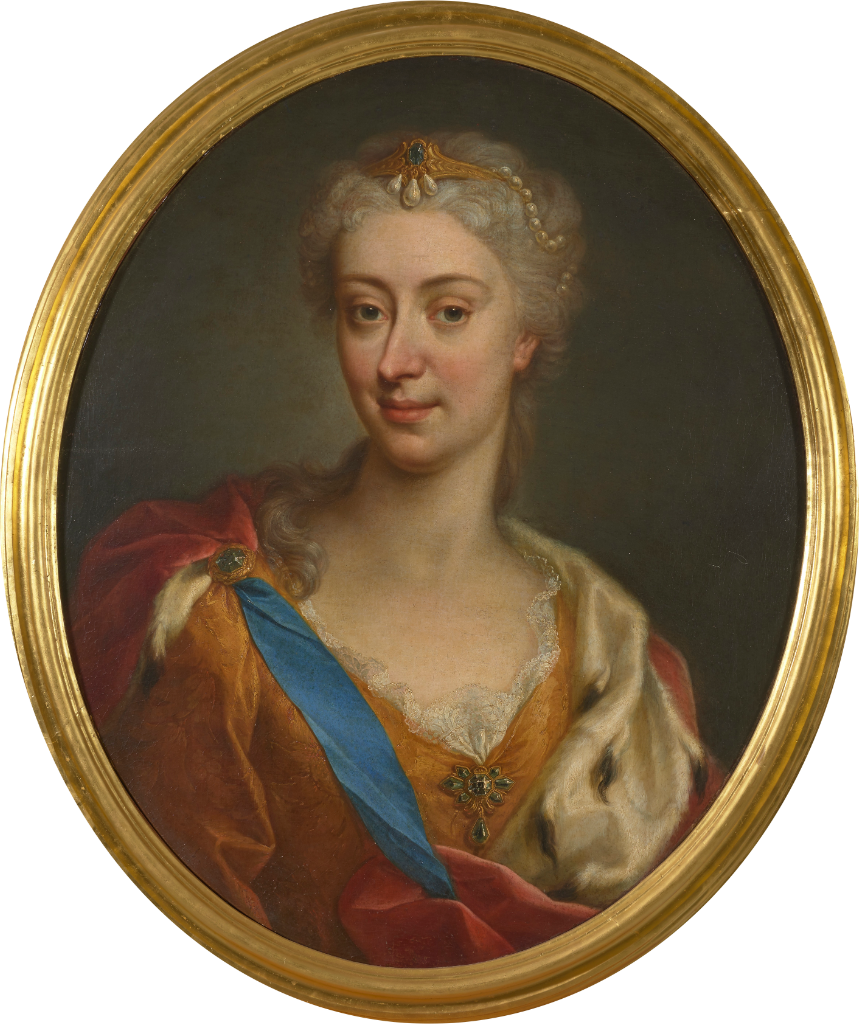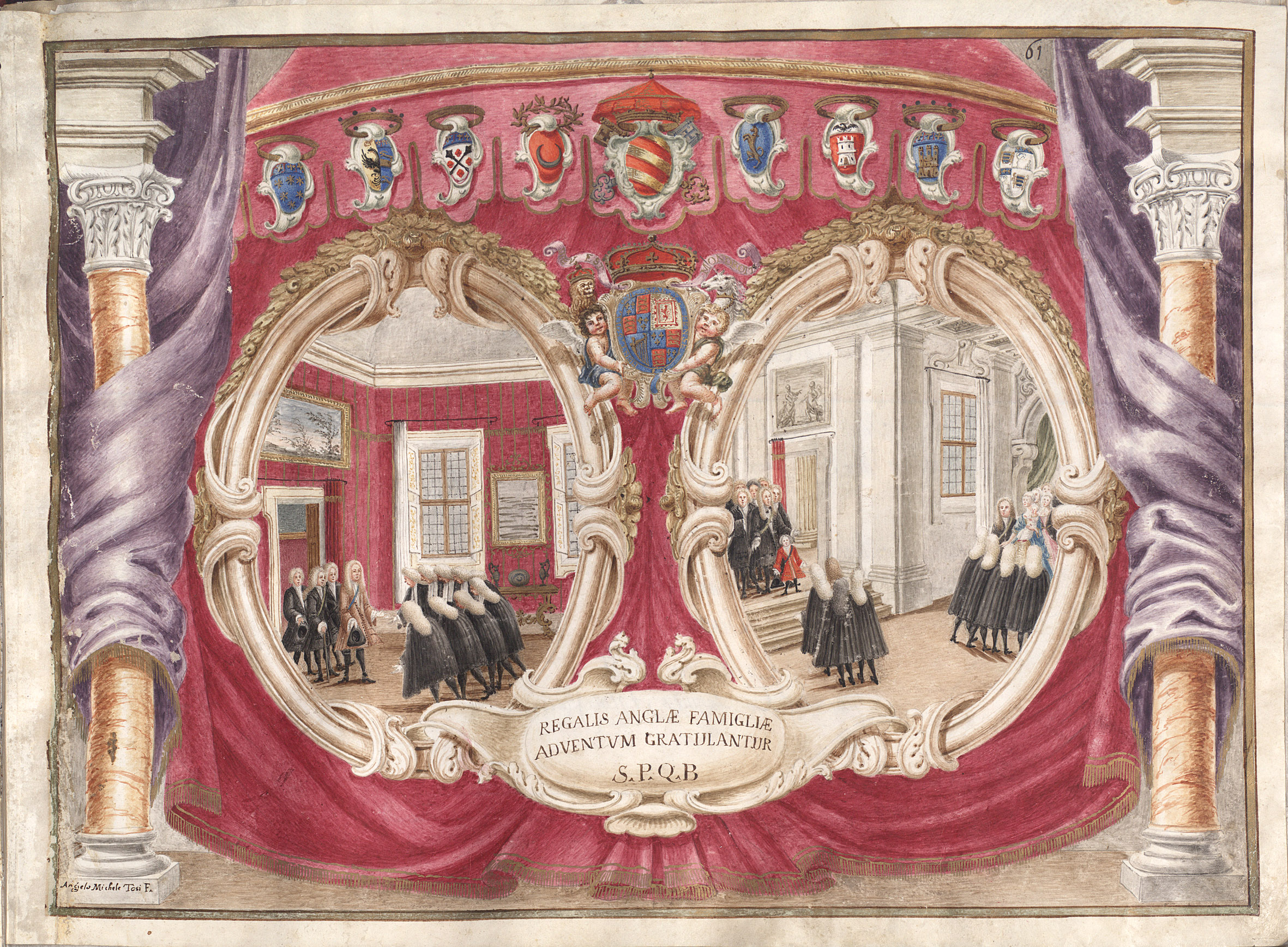Portrait of King Jan III surrounded by his family, unknown painter from the circle of the court of Jan III, after 1693
Portrait of King Jan III surrounded by his family, unknown painter from the circle of the court of Jan III, after 1693 - Photo gallery
oil, canvas, 73.5 x 108.5 cm
Museum of King Jan III's Palace at Wilanów
The group portrait depicts the Sobieski family: King Jan III (1629-1696), Queen Marie Casimire (1641-1716), eldest Prince Jakub Ludwik (1667-1737), younger sons Aleksander Benedykt (1677-1714) and Konstanty Władysław (1680-1726), daughter Teresa Kunegunda (1676-1730), Hedwig Elisabeth Amalia von Pfalz-Neuburg (1673-1722), wife of James and their daughter Maria Leopoldina. It is a work of small size, but with a strongly representative character exposing the dynastic plans of the Sobieski family, which were implemented with great intensity, especially in the years following the 1683 victory of the Vienna battle.
The political significance of the work is evidenced not only by the symbolic attributes found in the composition, but also by the way the figures are posed, their relationship to each other expressed through gestures and their place in the arranged scene[1].King Jan III and Queen Marie Casimire are seated on thrones set on a raised platform. Behind them is an open view of the palace architecture, obscured by a dark red curtain. The curled part of it, shown in the left-hand corner, features a motif of eagles in rhombus-shaped frames (the eagles refer to the emblem of the Kingdom of Poland).
A similar pattern is repeated on the carpets that cover the floor and the platform intended for the royal thrones. The king is dressed in armour; the lower part of the body is covered by plate armour, fragments of which can be seen from under the opulent golden mantle. In the upper part of his body we see a combined type of armour, consisting of the two types; an armour in which Jan III usually appears in portraits – a karacena (scale armour, at the bottom) and a leather breastplate all’antica with a rectangular cut-out at the neck decorated with an oblong stone. The mantle that covers the king's figure is girded with the blue ribbon (cordon bleu) of the Order of the Holy Spirit, awarded to Jan III in 1675 by King Louis XIV. The cross of the order is placed by the monarch's left hand, while his right hand is leaning on a regiment symbolising military command. Another motif displaying the monarch's qualities as a warrior are the sabre and shield suspended from the column on his right. The shield is decorated with Polish eagles in the rim and Medusa's head in the centre. This defensive motif is also an allusion to the Sobieski family coat of arms Janina – in a form of a shield. The election to the throne of another representative of this sign, the eldest son of the royal couple, Jakub, was to become a protection and a guarantee of security for the Polish Lithuanian Commonwealth. It is not without reason that he is depicted in the foreground, with one of his feet resting on the platform with the thrones. Jakub is dressed in West European plate armour, smeared with gold, his right hand supports the regiment, and on his chest is displayed the Order of the Golden Fleece – the highest decoration of the house of Habsburg, which he received in 1683, after he fought in Vienna battle, and was finally officially donated to him in 1691[2]. The same year he married Hedwige Amalia Pfalz-Neuburg, daughter of the Rhenish palatine Philipp Wilhelm. She is presented in the discussed painting on the other side to her husband, to the right of the composition. Hedwige Amalia had numerous siblings, and her sisters entered, through their marriages, the most important ruling houses in Europe: the Austrian and Spanish Habsburgs, the Portuguese royal family of Bragança and the Dukes of Parma Farnese[3]. In this context, the marriage contracted by Jakub Ludwik was highly prestigious, and his wife's collations increased his political chances in the contest for the Polish crown.
In the painting, Jan III and Marie Casimire are flanked on both sides by two columns, whose presence not only builds up the clear composition of the group portrait, but above all exposes the main characters of the scene. The symbolism of the column as an element supporting an architectural edifice is also telling. In this system of symbolic references, it was the royal couple who were supposed to be the support of the state – the Polish-Lithuanian Commonwealth. The columns' bodies form the background for the representatives of the next generation of the Sobieski family – on the male king's side, on the female queen's side. The younger royals, Aleksander and Konstanty, are positioned just behind their elder brother, but unlike him – they are both standing. They are dressed in armour inspired by Roman armour. The younger prince is wearing a karacena covered with leopard skin, Aleksander wears armour all’antica with a gorgonion on his chest, his left hand supporting a garment of animal fur, possibly also leopard. Unlike Jan III's eldest son, whose head is covered by a dark, long wig, the younger Sobieskis wear shaved hairstyles typical of the time and of the native fashion.
The women portrayed on the side of Marie Casimire are: her daughter Teresa Kunegunda, sitting sideways with her gaze turned towards the viewer; her daughter in law Hedwige Amalia Pfalz-Neuburg, mentioned earlier, and the granddaughter, Maria Leopoldina (most probably), sitting close to the queen. The portrayed women are dressed in gowns richly studded with stones: Marie Casimire in dark pink, Hedwige Amalia in green and Teresa Kunegunda in white. The queen's gown is covered by a voluminous, fleshy coat in blue, Hedwige Amalia is covered by a light blue coat on ermine. A similar, but intensely blue cloak lined with ermine fur is worn over the white dress of Teresa Kunegunda, who holds a basket of flowers in her hands. With her left hand, the queen tenderly holds the hand of Jakub's first-born daughter in a flower wreath on her head, while with her right hand she makes a gesture pointing to the girl and Maria Leopoldina’s mother. Perhaps, the queen is indicating the part of the family that should – by the anticipated election of Prince Jakub – continue the royal line and maintain the crown of the Commonwealth.
The attribution of the portrait has changed several times. It was described as a work of Jerzy Szymonowicz-Siemiginowski and Jan Tricius – court painters of Jan III. Today, it is definitively identified as the work of an unrecognised artist connected with the court of Jan III. Andrzej Ryszkiewicz[4], a scholar who dedicated a broad study to the group portraits in Polish art history, linked this work of art to an entry from the 1726 inventory of the Zhovkva castle. The description states: Obraz wielki, bez ram, na płótnie, ekspresja całej familii ś. p. króla jegomości (z Oławy), oryginał (A large picture, without frames, on canvas, expression of the whole family of the late king (from Oława), original)[5]. The author of the hypothesis suggests that the Wilanów portrait is a reduced copy of this very composition. The term 'original', which appears next to the inventory entry, may be a clue here, as it may indicate that – perhaps – already during the king's lifetime – repetition (or repetitions) of this scene were made. We come across traces of the practice of copying paintings from the Sobieski collection in inventory lists and other sources, but the clearest evidence remains of paintings that have repetitions, such as numerous portraits of the king himself. Mariusz Karpowicz found Ryszkiewicz's hypothesis plausible and, based on it, suggested that the author of the original could rather have been recalled above Jerzy Szymonowicz-Siemiginowski[6], a painter associated with Sobieski's court and a royal scholarship holder at Saint Luke's Academy in Rome. Despite the artistic shortcomings of the portrait, which are manifested, for example, in the schematic rendering of the physiognomic features of the portrayed, the presentation is an extremely valuable iconographic document in the stock of portraits of the Sobieski family. The strength of the work lies in its composition – the skilful arrangement of the plans and the figures depicted on them in a hierarchical manner[7], the complex symbolic message and the coherent connection of the portrait part with the architectural background. This indicates a very skilled painter of the original who, most probably, had other representative images of members of the royal family in his oeuvre and was familiar with the codified language of such iconography. Szymonowicz-Siemiginowski may be indicated by the presence of certain features or components that we find on other works attributed to him or associated with his workshop. These include, for example, the similarities in the positioning of the figure of Prince Jakub in the family portrait in question with the image that shows him in the company of the king-father[8], as well as the similar, combined outfit of Jan III in the engraved equestrian image according to Siemiginowski's drawing, transferred onto the plate by Charles de la Haye circa 1690[9]. Analogies with the works of the court painter of King Jan III can also be found in the king's physiognomic features or attributes that appear in the composition.
Finally, it is worth emphasising the clear analogies in the colour range between the portraits associated with Siemiginowski and his workshop and the painting in question. There is a dominance of warm colours such as ochre, yellow and gold contrasted with the intense red and ultramarine of the coats. It is also characteristic to combine complementary colours, such as blue with violet or yellow with green, in order to achieve a painterly effect of the shine or lustre of materials. This was the practice used by both royal scholars, Jerzy Siemiginowski and Jan Reisner in their works[10].
If we accept Ryszkiewicz's convincing version of the existence of a once original work for the painting in question, which has not been preserved to this day, we may particularly appreciate the documentary value of the Wilanów reduced copy – despite its artistic faults. Its importance, both historical and iconographical, can also be confirmed by the fate of the work, which, before it reached the former residence of Jan III, belonged to the collection of King Stanislaus Augustus (1732-1798, king in 1764-1795)[11], similarly as did the two equestrian portraits of the king and his wife, now also in the Wilanów collection (Wil.1685 and Wil.1686). In 1809 the portrait of the Sobieski family was purchased for the Wilanów collection by Aleksandra Potocka, the wife of Stanisław Kostka, both creators of the art collection held at the former residence of Jan III, which was made available to the public in 1805[12].
The original of this composition must have been created around 1694, after the birth of the first child of Prince Jakub and Hedwige Amalia, Maria Joanna Leopoldina (30 May 1693) and before the marriage of Teresa Kunegunda to Maximilian Emanuel Wittelsbach, on 15 August 1694[13]. The bridal state of Jan III's daughter may also be indicated by the basket of flowers she is holding, as well as the support of her feet on the footstool – she would soon become part of the Electorate of Wittelsbach. The wedding took place per procura (the groom being represented by Prince Jakub) in Warsaw, and it was not until November of that year that Jan III's daughter set off to meet the Elector.
Footnotes
[1] The representative character of the scene is indicated by Andrzej Ryszkiewicz, who points out that this is the only one of the Sobieski family portraits in which we see King Jan III in person, not through an image contained in the composition. The researcher suggests that the composition was intended for the reception rooms of one of the royal residences. A. Ryszkiewicz, Polski portret zbiorowy, Wrocław - Warsaw - Kraków 1961, p. 34.
[2] A. Skrzypietz, Królewscy synowie - Jakub, Aleksander and Konstanty Sobiescy, Katowice 2011, p. 171 and 183.
[3] A. Skrzypietz, op. cit., pp. 176-177.
[4] A. Ryszkiewicz, op. cit., p. 35.
[5] L. Finkel, Inwentarz zamku żółkiewskiego z r. 1726, "„Sprawozdania Komisji do Badań Historii Sztuki w Polsce”, vol. V, 1896, p. 44.
[6] M. Karpowicz, Jerzy Eleuter Siemiginowski malarz polskiego baroku, Wrocław - Warszawa - Kraków - Gdańsk 1974, p. 118. Incidentally, it is worth mentioning that the first researcher who attributed the work to Siemiginowski was Tadeusz Mańkowski, but he later changed the suggestion of authorship to Jan Tricius. See Idem, Malarstwo na dworze Jana III w Żółkwi, „Prace Komisji Historii Sztuki”, vol. IX, 1948, Fig. 38. The attribution was found next to the illustration; the painting is not discussed by the researcher.
[7] D. Walawender-Musz, Jan III Sobieski z rodziną, po 1693, [in:] Stanisław August, ostatni król Polski. Polityk, mecenas, reformator 1764-1795, exhibition catalogue, scientific edition A. Sołtys, Warszawa 2012, nr 131, s. 258-259.
[8] This portrait is also mentioned by Karpowicz when looking for similarities with the painting in question. The second one he mentions is an image of the king by Jan Tritius, Wil.1953. See footnote 5. Cf. M. Karpowicz, op. cit. p. 118.
[9] H. Widcka, Lew Lechistanu, Warszawa2012, pp. 414-415.
[10] K. Pyzel, W cieniu Siemiginowskiego - Jan Reisner i źródła jego twórczości, [in:] Jan III Sobieski. Historia - Dziedzictwo - Pamięć, edited by B. Dybas and A. Ziemlewska, Warszawa 2021, p. 108.
[11] T. Mańkowski, Galerja Stanisława Augusta, Lviv 1932, p. 419 no. 2013. I thank Dr Dorota Juszczak for her guidance on the origin and history of the portrait in the royal collection of Stanislaw August.
[12] In the context of the Wilanów collection it appears for the first time in the 1821 inventory of paintings, under no. 176: Spis Obrazów Willanowskich Dnia 10.8. br. R 1821; AGAD, AGWil, Zarząd Muzeum w Wilanowie, nr 166.
[13] Andrzej Ryszkiewicz gives 1692-1693 as the possible time of the painting's creation. See Idem, op. cit. p. 35.
